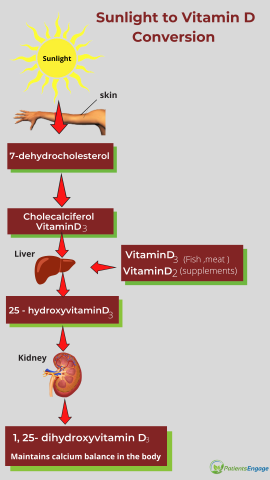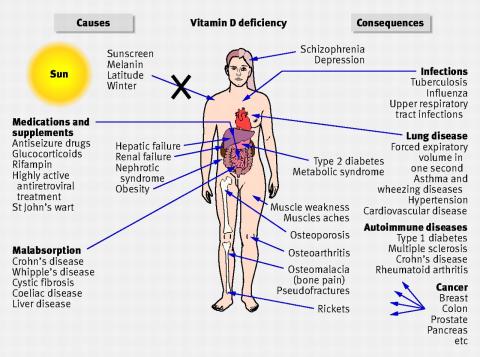
Prolonged lack of sunlight is the most common cause of Vitamin D deficiency, writes Shital Raval. And how can you treat Vitamin D deficiency.
It is as simple as stepping out of doors, yet a fear of sunshine is one of the factors that leads to Vitamin D deficiency. This in turn can give rise to a number of health conditions.
What is Vitamin D?
Vitamin D is a fat soluble vitamin which is structurally classified into D2 and D3. Vitamin D2 is known as Ergocalciferol and D3 is known as Cholecalciferol. These are stored in the liver and must be processed by the liver and kidneys into active Vitamin D or Calcitrol. This active form stimulates the absorption of calcium and phosphorus from the intestines. These minerals are incorporated into the bones, serving in bone growth and repair.

Where is Vitamin D found?

D2 is found in fortified foods, plants and supplements while D3 comes from fortified foods, meat products (cod liver oil, eggs,liver and fatty fish such as salmon, sardines etc.), supplements and UV radiation of the sun.
What causes Vitamin D deficiency?
- Lack of exposure to the sun for prolonged periods is one of the most common causes of Vitamin D deficiency.
- Use of certain medications, such as Glucocorticoids (made by the adrenal glands, and involved in the metabolism of carbohydrates, proteins and fat), anti-seizure drugs, anti-TB drugs, anticonvulsants, antifungals and even HIV/AIDS drugs.
- People with chronic kidney or liver diseases or failure, malabsorption disorders in which the intestines are unable to absorb vitamins and nutrients into the bloodstream, hyperparathyroidism and certain lymphomas also show low levels of the vitamin.

https://foodfashionandhealth.com/health/vitamin-d-deficiency-most-commo…
Who is at risk?
Those at risk of Vitamin D deficiency are:
- People above the age of 65 years of age, possibly due to less efficiency in absorption.
- Obese people due to poor nutrition or less bioavailability.
- Vegans (no consumption of meat, fish or dairy products)
- People who live in the northern latitudes such as northern Canada, and Alaska.
- People who do not receive adequate exposure to the sun.
- Dark skinned people who have a lot of melanin. Melanin tends to reduce the ability of the skin to make Vitamin D.
- People with digestive disorders.
- People with chronic liver or kidney problems.
What are the consequences?
The most common consequences of low or deficient Vitamin D levels are rickets in children and osteomalacia in adults. Vitamin D deficiency is linked to several serious diseases such as diabetes, multiple sclerosis, depression etc. It is also known to increase the risk of skeletal diseases, metabolic disorders, cancer, cardiovascular problems, infections, autoimmune disorders etc.
Globally, more than a billion people are known to be deficient in Vitamin and it is slowly been termed as a “Silent Epidemic of the Sun Vitamin”. In India, the deficiency prevails in 70-100% of the population due to poor exposure to the sunlight and consumption of foods that are not fortified with the vitamin.
Due to the fear of developing skin cancer, most people avoid sun exposure. This, as well as the use of sunblock lotions, window glasses or tinted glasses, full body coverage and regular indoor work, leads to reduced sun absorption even in abundantly sunny Middle East countries like Saudi Arabia.
What are the symptoms?
Although the only certain confirmation of deficiency is via testing of the blood, some signs and symptoms of Vitamin D deficiency may be seen, such as:
- Muscle or joint pain.
- Weakness.
- Fatigue, or feeling tired all the time.
- Depression.
- Excessive sweating on the head.
- Gut/digestion problems.
How is Vitamin D deficiency diagnosed?
It only takes a simple blood test to check for the vitamin levels in the blood. There are two types of tests done: One is 1,25(OH)2D which is not a good measure of the correct levels. Second is the testing of 25(OH)D which is the preferred and more accurate test of the vitamin.
25 HYDROXY D LEVELS
Deficient: <50 ng/ml
Optimal: 50-70 ng/ml
Cancer & Heart disease: 70-100 ng/ml
Excess: >100 ng/ml
*Multiply ng/ml by 2.5 to convert to nmol/litre
What is the treatment?
The best option would be to get out into the sun twice a day for 15 minutes each as preventative measure and even in the early stages of the deficiency.
The wide choice of treatment is via supplements. The amount of supplement needed will depend on the severity of the deficiency and relevant health risks.
For adults and children (under 18 years of age) a weekly or daily dose is recommended till blood levels reach above 30ng/ml. In patients with obesity or malabsorption disorders, a higher dose is recommended to reach the same level of 30 ng/dl.
What is the recommended intake?
600 IU/day for everyone under the age of 70.
800 IU/day for people aged 70 or above.
600 IU/day for pregnant and lactating women.
How should supplements be taken?
It is recommended that Vitamin D supplements be taken with a meal that contains fats. Studies show that there is 32% or more Vitamin D absorption in a meal containing fat. One study showed an average increase in blood level of 56.7% in people who ate the supplement with their largest meal of the day.
Supplements can be taken daily, weekly or monthly as prescribed by your primary care physician. This will depend on your current level of Vitamin D levels. Blood testing is recommended after two to three months to make sure the supplements are working.






